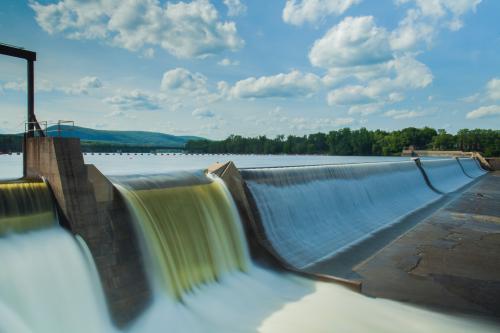This post is the first in a series examining how local leaders across the U.S., including utilities and other community groups, are accelerating efforts toward identifying, hiring, training, and retaining the future water workforce—a segment of the labor force seeing a rise in retirements and struggling to fill jobs, even though these positions offer clear pathways to economic opportunity.
Investing in water infrastructure represents a major challenge and opportunity across the United States. As pipes, plants, and other facilities reach a breaking point, utilities and local leaders must plan and pay for increasingly costly repairs. However, many places have responded with innovative approaches, using new management techniques and modern technologies to deliver water infrastructure that is more cost-efficient, durable, and resilient.
Crucially, these challenges and opportunities do not simply end with the infrastructure itself.
The country’s water workforce is also undergoing change. Similar to millions of other workers involved in infrastructure nationwide, the water workforce is aging, experiencing rapid turnover, and facing a huge gap to fill in terms of hiring, training, and retention—from operators and engineers to accountants and office clerks. At the same time, these jobs offer competitive wages, have lower educational barriers to entry, and consequently provide a pathway to greater economic opportunity for all types of workers across all skill levels.
While many localities—and water utilities, in particular—continue to struggle to fill these positions, some places are leading the charge toward more coordinated, proactive recruitment and training. California’s Bay Area represents one such national leader.
Like most parts of California, the Bay Area faces a confluence of environmental and economic concerns. The state is ground zero for a variety of national water challenges, including water scarcity and affordability issues that extend to the Bay Area. Of course, getting even more attention are the region’s economic issues, including its astronomical cost of living and rising income inequality.
However, by forging new partnerships and programs across the entire region, Bay Area water utilities are working closely with one another and various community groups to tackle these challenges head-on—with a particular emphasis on workforce development. Although most utilities across the country remain highly fragmented and localized in their operations, capital planning, and workforce development strategies, the Bay Area demonstrates how to build additional financial and technical capacity in support of the water workforce, often through broader regional collaborations.
Individual utilities, public agencies, workforce organizations, and regional coalitions: each is instrumental in hiring, training, and retaining workers at a larger scale.
The efforts begin within individual utilities and public agencies that depend on forward-looking leadership to implement more purposeful, long-term programming. The San Francisco Public Utilities Commission continues to play a lead role—both regionally and nationally—in driving the creation and implementation of youth work programs, local job training programs, and other strategic plans in support of a more skilled, diverse workforce. Similarly, the East Bay Municipal Utility District promotes awareness and outreach for careers in the water sector through diversity initiatives and internship programs. Toward the South Bay, the Santa Clara Valley Water District and the City of San Jose each spearhead efforts focused on targeted recruiting, skills development, and a more inclusive workforce.
This sense of shared responsibility helps set the table for BAYWORK, a consortium of Bay Area water and wastewater utilities focused on workforce development. This multi-stakeholder approach helps provide a regional platform to coordinate utility and communitywide activities. In addition to holding workshops, meetings, and other events to promote greater regional collaboration around (and visibility of) the workforce challenge, BAYWORK also uses new research and other training resources to help clarify strategic priorities. For example, by identifying the skill needs and current positions available for mission-critical occupations, such as water treatment operators, machinists, electricians, and electronic maintenance/instrument technicians, BAYWORK is supporting additional community outreach and building local capacity to hire and train that specific workforce.
To be sure, prioritizing regional workforce development does not simply begin or end within the walls of utilities; the need for broader collaborations with workforce groups, local educational institutions, unions, economic development officials, and political leadership is essential to build additional capacity for these efforts.
Among the Bay Area’s numerous workforce organizations, for instance, Jewish Vocational Service (JVS) is helping utilities find qualified candidates by connecting workers with training opportunities and stewarding new partnerships. Similarly, Young Community Developers (YCD), a non-profit group with activities concentrated in San Francisco’s Bayview Hunters Point neighborhood, provides job-readiness training and job placement assistance to residents who may face significant barriers to launch water careers. A number of high schools and technical schools, such as Los Medanos College and Laney College, also remain instrumental in helping students gain essential skills and on-the-job training through direct partnerships with utilities.
Individual utilities, public agencies, workforce organizations, and regional coalitions: each is instrumental in hiring, training, and retaining workers at a larger scale.
Indeed, for other regions looking to replicate the Bay Area experience, it is the coalition of partnerships and the emergence of shared strategies that deserve closer attention. Recruitment, for instance, must touch all corners of a community to attract more workers and achieve greater diversity, which depends on gaining traction among a broad set of regional players. To promote more inclusive economic development, utilities and local leaders must be able to tap the talent of the entire region, and water jobs must be more accessible to more prospective workers in more places.
Of course, adopting such a shared, regional approach flies in the face of the jurisdictional fragmentation and competition that frequently exists in the water sector. Many utilities lack the staffing and budgetary capacity to create new recruitment and training programs or struggle to connect with other regional partners, as their workers retire or leave for opportunities elsewhere. Moreover, hiring additional workers and setting up pathways for continued learning are part of a winding, long-term process, which requires monitoring and evaluation. Utilities must also contend with an ever-growing number of financial and programmatic responsibilities that can be hard to balance all at once. Even regions with a track record of success like the Bay Area are not immune to these challenges.
While all of these issues can increase the degree of difficulty of filling the water workforce gap, they do not reduce the need. The clock is ticking for many utilities and other employers nationally, and the need to accelerate workforce development is only growing. However, having a collective, aspirational mindset that prioritizes workforce development at a regional scale is an important start—and it’s an approach worthy of replication.
Thanks to Annie Rice for research assistance on this post.
Photo credit: Lucy Nicholson via Reuters.
The Brookings Institution is committed to quality, independence, and impact.
We are supported by a diverse array of funders. In line with our values and policies, each Brookings publication represents the sole views of its author(s).






Commentary
Investing in water infrastructure and workers: Examining the Bay Area’s regional approach
March 7, 2018